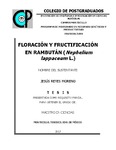Floración y fructificación en rambután (Nephelium lappaceum L).
Abstract
El rambután (Nephelium lappaceum L.) es una especie de la familia Sapindaceae que en los últimos 10 años ha tenido gran relevancia económica y comercial en la región del Soconusco, Chiapas. Las condiciones agroecológicas idóneas para el cultivo son: precipitaciones anuales de hasta 3,000 mm, temperaturas de 26 a 32 °C con buena luminosidad durante todo el año. Este cultivo se adapta a altitudes que van desde el nivel del mar hasta los 1,200 m. El rambután se cultiva en algunos países del Continente Americano como Costa Rica, Panamá, Honduras y México. Actualmente, se cuenta con escasa información sobre aspectos anatómicos y morfológicos en rambután. El presente trabajo abarca aspectos estructurales sobre la floración y la fructificación, en las condiciones ambientales del Soconusco Chiapas donde se cultiva de manera intensiva actualmente. Se realizaron cortes anatómicos del esporofito reproductivo comprendiendo desde las yemas iniciadas y hasta los frutos maduros, utilizando la técnica convencional para la obtención de preparaciones histológicas permanentes de material incluido en parafina y teñidos con safranina y verde fijo. También se describen los procesos fenológicos reproductivos relacionados con dos principales aspectos ambientales más importantes como la temperatura y la humedad relativa. _______________ ABSTRACT: The rambutan (Nephelium lappaceum L.) is a species of the family Sapindaceae that in the last 10 years has had great economic and commercial relevance in the region of Soconusco, Chiapas. The agroecological conditions suitable for cultivation are: annual rainfall up to 3,000 mm, temperatures from 26 to 32 ° C with good light throughout the year. This crop is adapted to altitudes ranging from sea level to 1,200 m. The rambután is cultivated in some countries of the American Continent as Costa Rica, Panama, Honduras and Mexico. Currently there is little information on anatomical and morphological aspects in the rambutan. The present work includes structural aspects on induction, initiation, diffrenciation and fructification, in the environmental conditions of Soconusco Chiapas where it is cultivated intensively at the present time. Anatomic sections of the vegetative and reproductive sporophyte were made, ranging from the buds to the mature fruits, using the conventional technique of microtechnology to obtain permanent histological preparations of material included in paraffin and stained with safranin and fixed green. It also describes reproductive phenological processes related to two main environmental aspects, such as environmental temperature and relative humidity.
Collections
- Tesis MC, MT, MP y DC [138]


